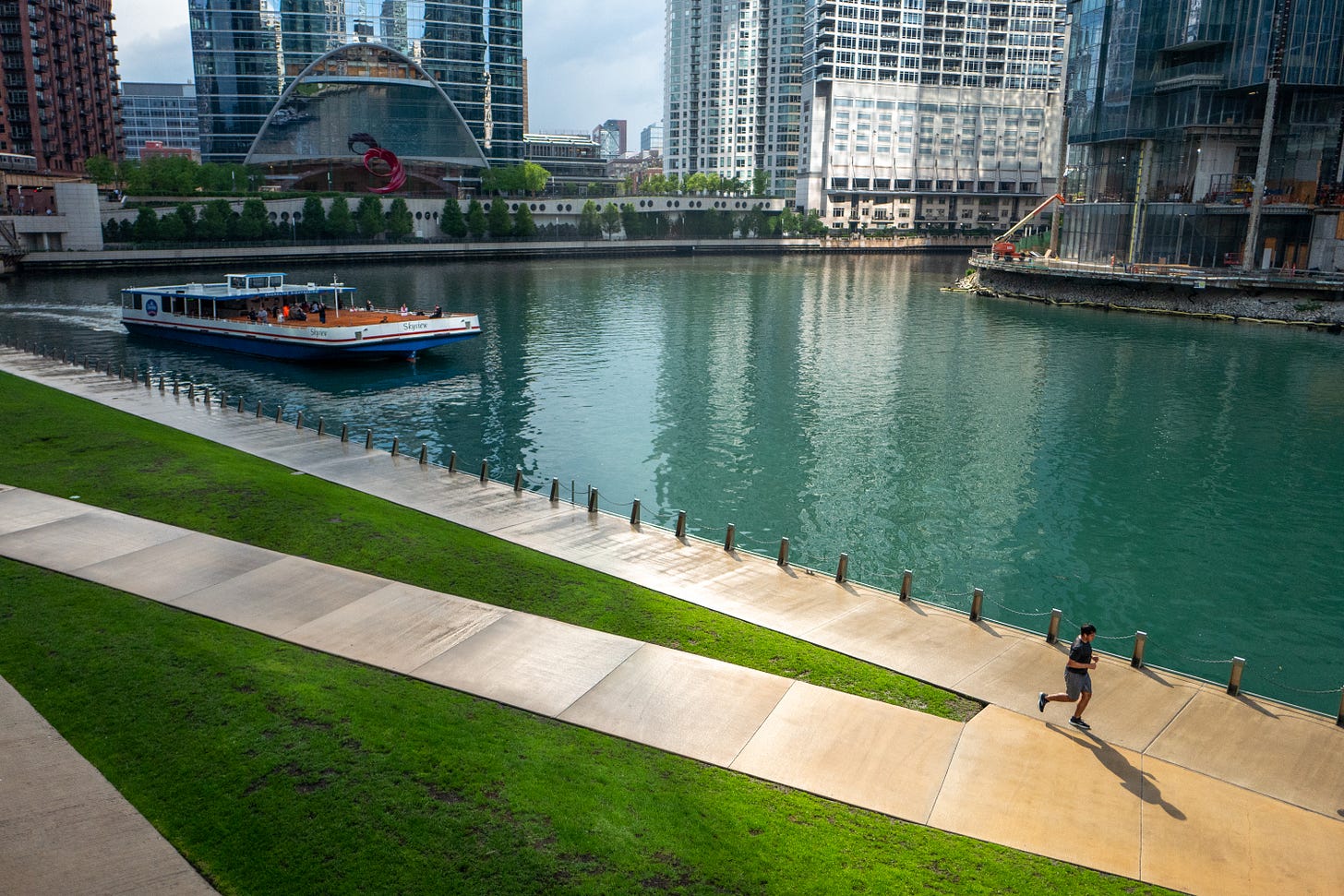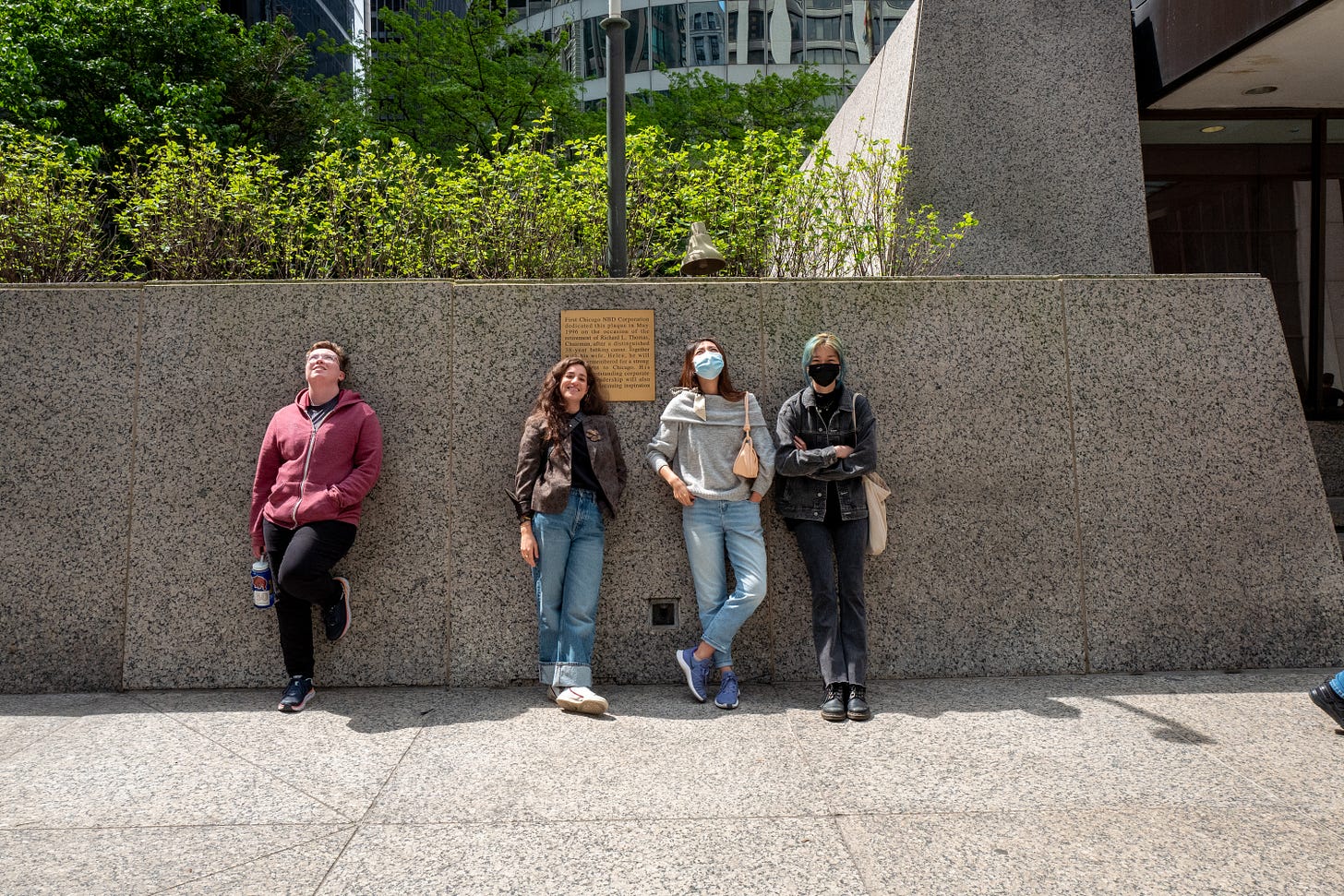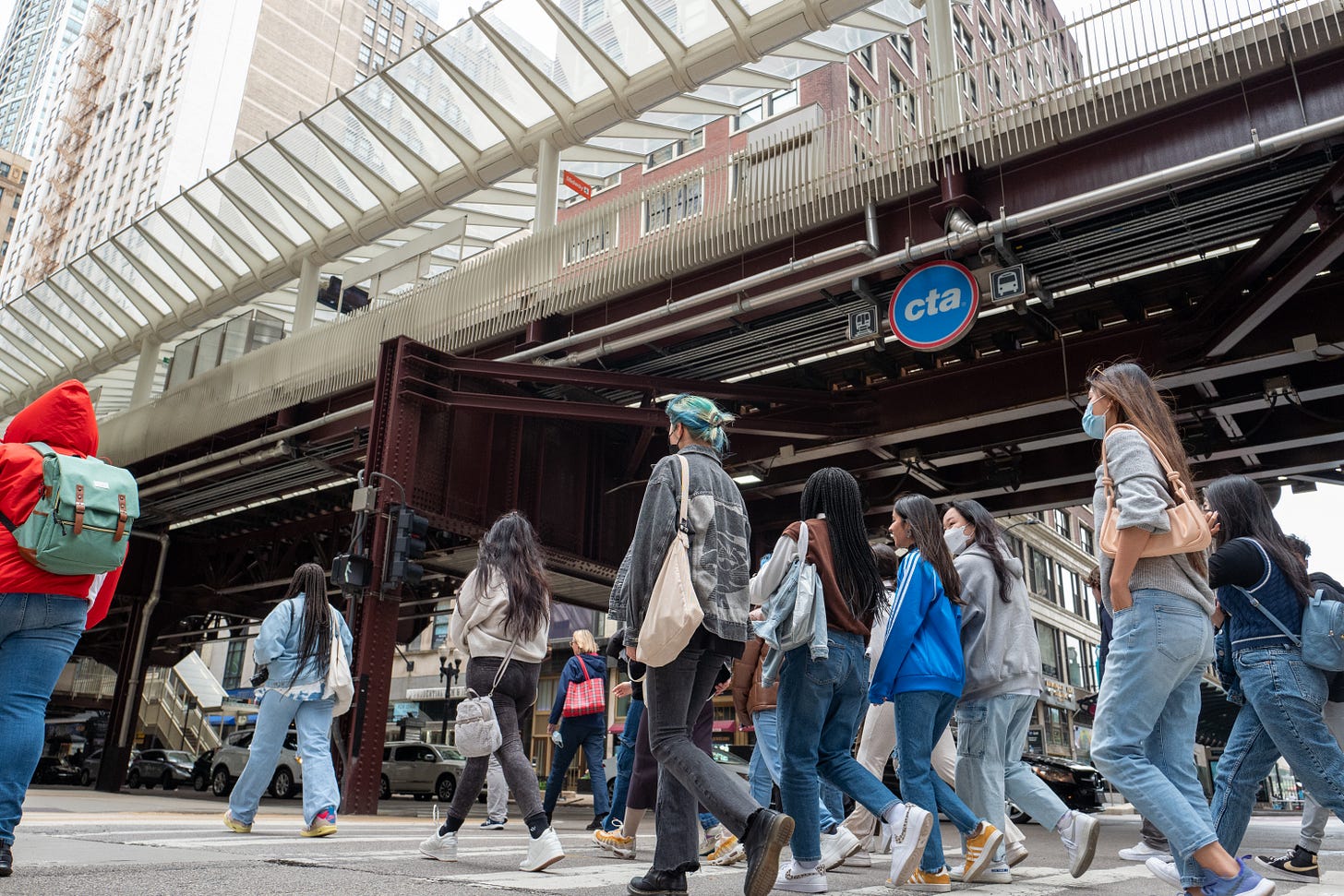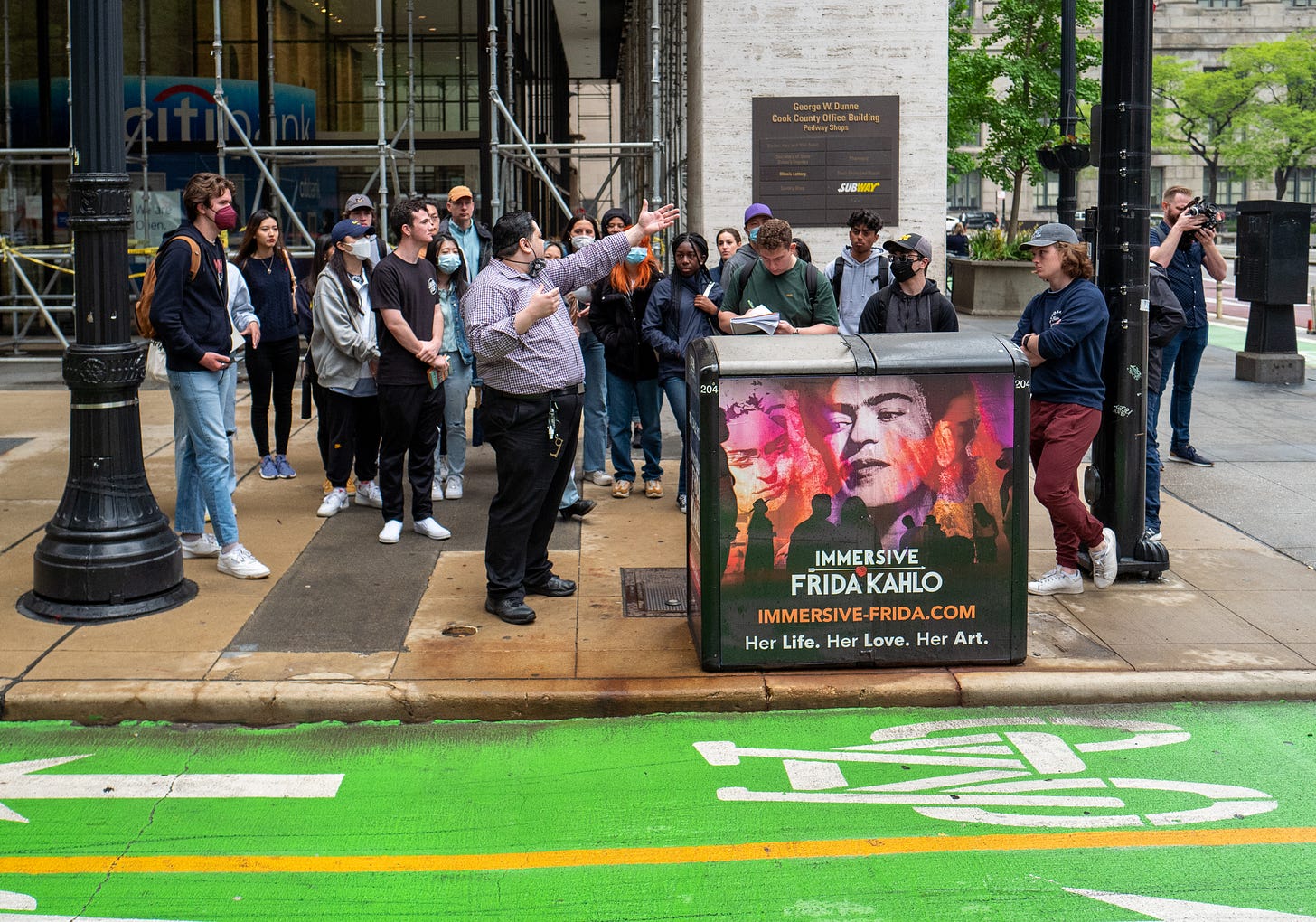Urban Technology at University of Michigan week 96
Navigating Mobility, Access, and Freedom in Chicago
“Is the adobo your usual order? …Is it better than the sisig? …Does urban technology touch on fintech (financial technology) at all? …Is it better to build more rail and put housing next to it or focus on putting more housing next to existing rail lines?” Idle chitchat with friendly strangers while waiting for lunch at the Revival Food Hall in downtown Chicago. You were nothing if not midwestern, Chicago: welcoming, broad, blue-skied, supraficial.
After returning from our trip to understand drinking water in and around Toledo, the students had a short break before we boarded the bus again and set off for the Nature’s Metropolis. Fittingly for people who arrived by bus, the theme of the trip was mobility.
Thanks to all of our hosts, who you’ll hear more about below: Metropolitan Planning Council, Brendan Dodge-Hayakawa of the Chicago Transit Authority, Shared-Use Mobility Center, Bosch and the Chicago Connectory, Elevated Chicago + Palenque LSNA + Bickerdike Redevelopment Corporation.
💬 Hello! This is the newsletter of the Urban Technology program at University of Michigan, in which we explore the ways that technology can be harnessed to nurture and improve urban life. If you’re new here, try this 90 second video introduction to our degree program.
🚶 Freedom & Movement
We visited Chicago to understand the plurality of ways that people move from A to B and, as guest speaker Benjie de la Peña reminded us, to C and D and E as well. What does it take to make different mode of transit work, how do they interconnect or even compete, and what does all of this mean for equity in cities?
Though the professors teaching our Cities Intensive this summer—Phil D’Anieri and Toban Shadlyn—did not use these exact words, one of the things we explored in Chicago was the definition of freedom. If America is a place that’s obsessed with freedom, then how can mobility uphold this value?
Transit consultant Jarrett Walker often writes that “frequency is freedom,” by which he means that if public transit runs infrequently you’re more likely to feel that it’s a last resort than it is a convenient option. Freedom, as Benjie described to the group when we visited him as mobility gigabrain and CEO of the Shared-Use Mobility Center, is having the choice to move how and when you want to. Not only are humans are complex organisms that change their minds regularly, what one needs today may not be what one needs or wants tomorrow, so urban mobility should be experienced as a boisterous spectrum of options rather than the binary of private car versus all the other stuff. In Benjie’s words, “do you really want to buy a truck just because you might go to Ikea once a year?”
It’s not crazy to want the freedom to easily move yourself and the stuff that’s important to you, but it actually is pretty crazy to buy an expensive object on the off chance that you might need to use it every now and then. Especially when those big expensive objects sit parked and unused 95% of the time and grow larger and deadlier every year. Does one need a truck taller than a middle schooler to ensure the convenient delivery of some IVAR shelving? Does the freedom of the truck owner outweigh the freedom of the pedestrian to enjoy the public realm without threat of injury or death? The answer to that last question in America right now is unfortunately, “yes,” but if folks like Benjie or Audrey Wennink have anything to say about it, that answer will change soon.
As Director of Transportation at the Metropolitan Planning Council (MPC), Audrey hosted our group to share her work advocating across the region with community and governmental stakeholders alike for lower carbon, more accessible, and better transit. Making strides in this work will require better data on the full spectrum of mobility. Today’s decisions about the right of way are overwhelmingly made by departments of transportation and traffic engineers, using data that measures the efficiency of automotive throughput. Whereas every cellphone in the country has a detailed map and routing system of vehicular paths, “there’s not a single [consolidated] GIS layer of bike paths in the Chicago region. Only four years ago we got the first GIS layer of sidewalks.” Data won’t fix transit on its own, but data gathered conscientiously and used in appropriate ways can make the downsides of the status quo unbearable and inspire action.
New data means new priorities means new roles. MPC are advocating for the role of "Mobility Coordinator" as someone who coordinates between land use management, mobility services, and fundamentals like healthcare and access to food. Such a position would presumably also be helpful in the region’s transition plan to make its transit network accessible. Currently only 22 of the 200 municipalities in Chicago have a transition plan in place, according to MPC. How much is freedom worth when it hits a roadblock at the edge of town?
It’s not just transit riders for whom freedom is important; freedoms are critical to the the operators of a system like the Chicago Transit Authority (CTA) as well. Brendan Dodge-Hayakawa, Bus Scheduling Analyst with the CTA, led a tour by foot, train, and bus all the while narrating the symphony of the system. By 2030 the CTA is aiming to make the entire rail network accessible and by 2040 they hope to electrify all of the busses, but it’s not just long term goals that drive their work. Brendan and his colleagues are continually tweaking the schedule and other details of the bus network to serve riders better.
As much as one might like to imagine the planning that goes into a bus network like the CTA’s can be automated, the final design of routes, headways, and all the other glorious minutia of getting you across town on time are the result of diligent work by Brendan and his colleagues, for whom it’s clearly a labor of love, “You think a computer [makes the schedule] and it can help, but at the end of it you’re pulling out a piece of paper and doing things by hand.”
Decisions are driven, in part, by data about ridership. Simple break beam sensors near the entry and exit doors tell the CTA how many people are using each bus but sometimes the data comes back messy because, for instance, a group of university students clog the aisle and the sensor cannot interpret this kind of event. Sorry for the small dent in your transit data, Chicago! When asked whether CTA could use the 12 cameras already on each bus to perform ridership analysis, we learned that this would require State approval to repurpose the camera data, which is currently only authorized for use related to rider safety.
Privacy is a freedom too, and an important one, but sorting out concepts of freedom gets more difficult when individual rights to privacy push against a city’s imperative to refine and improve the mobility of its population. This false dichotomy should not be a stopping point but a call to action for better and more nuanced technology.
On-device analysis and de-identification are technical approaches that can be applied to address privacy concerns in a setting such as this, to be sure. The bigger and more important point from Brendan’s tour was that the counterpart to Jane Jacob’s “ballet of the sidewalk” enacted by humans is a symphony of the system whose notes are played by politics, institutional norms, and money, though he didn’t exactly use the word “symphony.” The CTA exists between this ballet and symphony 24 hours a day and 365 days per year.
Later that day we visited Beth Bond at the Bosch’s Chicago Connectory. She brought a different data question to the group: how can the ‘data exhaust’ from contemporary vehicles be used to make decisions about streets that could be utilized to enable better outcomes? For example, how can the 150,000 lines of raw data generated by a new vehicle every single minute be utilized by cities to understand through empirical evidence where road networks need to be redesigned? Could the connected brakes and other vehicle components that Bosch builds for companies like Ford or Tesla help municipal planners improve pedestrian safety? And if that data is used for purposes beyond the vehicle itself, how and when should drivers be notified of the privacy and security dimensions of this data sharing? Should it be opt-in or required? These are questions of freedom too, and not simple ones.
On our final day in Chicago we visited Logan Square to ask an important mobility question: what if the best travel is no travel at all? What if the “choice architecture” of the city provided everyone with ways to get the things they need without forcing them to exercise the “freedom” of movement, which comes with the moneycost of owning a car or the timecost of waiting for underfunded American busses and trains? How would a city measure the freedom of its people as a collective, rather than indexing individual self reliance?
In a book from 2019, U-M colleagues Jonathan Levine and Joe Grengs describe this as a shift of focus from “mobility” to “access” that requires transportation and land use planning to be seen as one interconnected activity. In Chicago we visited the Lucy Gonzales Parsons apartment building which embodies this approach and is an example of “equitable transit oriented development.” The building’s 100 units are all affordable housing and it’s located just steps from the Blue Line in a gentrifying neighborhood.
Previously a city-owned parking lot occupied the site, but through continuous and vigilant organizing by Elevated Chicago and Palenque LSNA (neighborhood association) the city agreed to repurpose the lot to provide dignified and accessible housing for long-term neighborhood residents including Logan Square’s Latinx residents, 47% of whom have been displaced in the past twenty years according to Elevated Chicago’s Marly Schott.
“The building is affordable but not cheap,” described Joe Dunne with the Bickerdike Redevelopment Corporation. Freedom of choice emerged unexpectedly in this conversation as well: affordable housing sometimes involves making design decisions that would be unfathomable in contemporary market rate housing, such as providing heating and cooling without individual thermostats in each unit. On the contrary, each unit in the Lucy Gonzales Parsons building has its own thermostat, fresh air fed directly from the roof, high quality insulation, and durable materials like quartz countertops—amenities that are standard issue for many, but can be rare in an affordable building.
The lesson here is that careful and caring decision making, planning, and design should yield greater choice and more freedom for individuals regardless of their socio-economic status. That’s as true for building systems technology as it is for any other kind of tech. Freedom is critical here because mitigating gentrification is not about merely keeping communities in place, but enabling everyone in a given place to be a full member of the community. The opposite of gentrification is not colocation, but equality of choice.
Inspired by their progress with this one building Palenque’s Director of Housing, Christian Diaz, spoke animatedly about efforts to now reimagine Logan Square itself as a center of Latinx culture, including the pedestrianization of the street that cuts through it to make more room for people. His sendoff for our group was a strong call to action for the future hackers, civil servants, designers, and doers of our group:
“Do not accept the world as it is. Do not accept the status quo. Gentrification is not natural. The people who made decisions before were not smarter than us. Don’t be afraid of power; take power.”
These weeks: logistics, travel, hiring. Sometimes the little running person at the end of this newsletter feels very apt. 🏃











